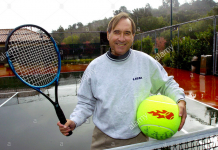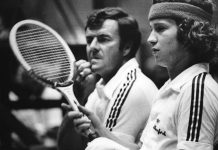He wasn’t a regional czar, like Southern California’s Perry Jones in the old days. Nor was he some kind of Tennis Godfather. He wasn’t a bright ‘n’ brainy marketeering whiz or a center-of-it-all administrator. Rather, Bob Cookson was his own singular figure — intense, powerful, wise, funny, giving, dismissive, often crusty and supremely confident. By the force of his will, knowledge, generosity and considerable presence, he was for a generation the most powerful man in NorCal tennis politics. If you wanted something big to happen in these parts, Bob was your man. You’d best have him on your side.
As a lad, Cookson crossed the bleeding plains of Europe with George Patton’s liberating armies. As a man with a no-nonsense approach to business and an unshakable authority, he cast a considerable shadow. Seen so often in his patented white cap, he was tennis’ old-school answer to former NFL coach Tom Landry: on the sidelines and in command, a stern winner — knowing and respected.
Cookson began as just another kid at San Francisco’s Galileo High. He survived the Battle of the Bulge and returned home to enter his family’s fledgling door business. A gifted and savvy businessman, he and his clan transformed the company into a $60 million force. Soon he would come to enjoy the treasures of life — an enchanting wife and three accomplished sons.
This was a fellow who was happy to indulge life’s manly joys: smoke-filled parlor rooms and male-bonding campfires. He raced his car on nearby tracks or went full-throttle in his boat on serene mountain lakes. Cigars and poker, weekend jaunts to Vegas or Reno, he rose to prominence in San Francisco’s powerful Bohemian Club, gathered a world class jade collection and was a leading member of Burlingame’s Peninsula Tennis Club.
Yet (here’s a shock) he felt rather powerless because his club was about to lose its beloved junior hard-court tournament. So in ’77, Cookson launched his 31-year odyssey in tennis politics by serving on the USTA NorCal’s sanctions committee and becoming the group’s budget chairman and president. With an unerring eye for detail and commitment to principle, his rise — quick and certain — was a part of the USTA NorCal’s heady golden era (active, collegial volunteers, fresh ideas, stable administration) before a semi-permanent civil strife (“If you’re really my buddy, give me your proxy”) came to prevail.
Cookson also enjoyed a mercurial rise on the national scene. Sure, like the oilmen and insurance executives who proceeded, he was an affluent businessman with a deep love of tennis and plenty of discretionary time and money. But beyond this — more than any other volunteer we’d ever encounter — he had a fierce loyalty to the USTA. When rebel Kim Fuller led an insurgency, which insisted NorCal act more independently of the national USTA and that past presidents be removed as Board members, Cookson bristled. When the USTA’s traditional institutions — Flushing Meadows, Super Saturday, the Davis and Fed Cups — were criticized, Cookson countered: “A lot of people are just looking for controversy and want to bash us…we are picked on unfairly.”
No wonder that in ’91, the USTA looked to their stellar loyalist and rising leader to be president. A macro-manager with a trust-your-staff style, Cookson crafted a memorable, more-than-hefty legacy: moving the group’s headquarters to suburban White Plains, upgrading the U.S. Open’s site, helping to jumpstart player development, insisting on much needed initiatives for minority participation, and at last marketing the USTA (including the spiffy logo he relished so much).
As his pal Don Colburn noted at a January 10th Bohemian Club memorial service attended by hundreds, “Bob was a direct guy. He let you know if he approved or disapproved.” So when the venerable Bud Collins was critical, Cookson dismissed him as that “Boston Globe man.” When icon Arthur Ashe spoke of racism, Cookson responded, “Oh, that’s just Arthur.” When an anti-U.S. Open poll and survey emerged, he dismissed it as a “French put-up job.”
Cookson didn’t hesitate to take on the bad boys of the game. He asserted that John McEnroe didn’t “have the maturity” to be Davis Cup captain. [McEnroe] could never be the representative of the USTA. It’s not in the cards.” When Jimmy Connors complained about playing back-to-back U.S. Open matches, Cookson said that that’s what is expected of modern athletes and that Connors was actually playing the Open because of him. [Bob had given the popular champ a wildcard into the tournament.]
Cookson was more than skeptical of the media, which he felt were far too negative and always had to have the last word. To him, the press, with its “limited judgment, didn’t need to second-guess” USTA decisions. No wonder his many interviews with this publication often resembled 15-round bouts in which the three-knockdown rule was suspended.
But in the end, as Dick Gould noted, Cookson was “a shrewd man of foresight who thrived on challenges.” His greatest act of foresight was marrying his wife, Betty, who, as far as USTA first ladies went, came as close to Jackie Kennedy as any. The two would travel up to the Taj Mahal and down the Nile, visit the Queen of England and venture to inner-city tennis venues. Ultimately, Cookson will be remembered as a modest man who, in quiet ways, generously helped so many. A man who wanted to make a difference, Bob Cookson — a Patton grunt, who knew how to make tough doors and tough decisions — has left us: a fallen giant with a mighty shadow, a tireless volunteer who gave so much to the game he loved so dearly.


















